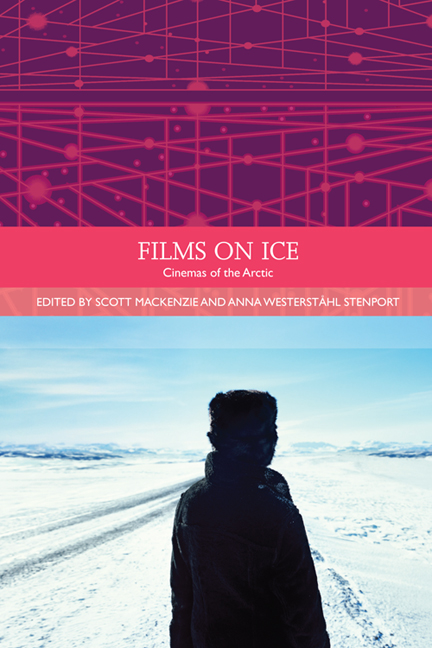Book contents
- Frontmatter
- Contents
- List of Illustrations
- Acknowledgements
- Traditions in World Cinema
- Introduction: What are Arctic Cinemas?
- PART I GLOBAL INDIGENEITY
- PART II HOLLYWOOD HEGEMONY
- 8 Fact and Fiction in ‘Northerns’ and Early ‘Arctic Films’
- 9 California's Yukon as Comic Space
- 10 ‘See the Crashing Masses of White Death…’: Greenland, Germany and the Sublime in the ‘Bergfilm’ SOS Eisberg
- 11 The Threat of the Thaw: The Cold War on the Screen
- 12 Hollywood Does Iceland: Authenticity, Genericity and the Picturesque
- 13 White on White: Twenty-First-Century Norwegian Horror Films Negotiate Masculinist Arctic Imaginaries
- PART III ETHNOGRAPHY AND THE DOCUMENTARY DILEMMA
- PART IV MYTHS AND MODES OF EXPLORATION
- Notes on the Contributors
- Index
13 - White on White: Twenty-First-Century Norwegian Horror Films Negotiate Masculinist Arctic Imaginaries
from PART II - HOLLYWOOD HEGEMONY
Published online by Cambridge University Press: 05 September 2016
- Frontmatter
- Contents
- List of Illustrations
- Acknowledgements
- Traditions in World Cinema
- Introduction: What are Arctic Cinemas?
- PART I GLOBAL INDIGENEITY
- PART II HOLLYWOOD HEGEMONY
- 8 Fact and Fiction in ‘Northerns’ and Early ‘Arctic Films’
- 9 California's Yukon as Comic Space
- 10 ‘See the Crashing Masses of White Death…’: Greenland, Germany and the Sublime in the ‘Bergfilm’ SOS Eisberg
- 11 The Threat of the Thaw: The Cold War on the Screen
- 12 Hollywood Does Iceland: Authenticity, Genericity and the Picturesque
- 13 White on White: Twenty-First-Century Norwegian Horror Films Negotiate Masculinist Arctic Imaginaries
- PART III ETHNOGRAPHY AND THE DOCUMENTARY DILEMMA
- PART IV MYTHS AND MODES OF EXPLORATION
- Notes on the Contributors
- Index
Summary
One of the tenets of Norwegian nationalism is the mastering of snow and cold climates, encapsulated in the motto ‘Norwegians are born with skis on their feet’. The national discourse of what Benedict Anderson calls an ‘imagined community’ originated in the nineteenth century, when, looking for the idea of a Norwegian essence, the Norwegian elite chose extreme nature to symbolise the young nation but also promoted a relationship of superiority to it. These assumptions persist: ‘Mountains, snow and winter had so far been seen as obstacles to life and culture – thanks to national Romanticism in the arts, the fledgling tourist industry and organized winter sports, these obstacles were over time transformed into assets and claims of a specific “Norwegianness”’ (S ørenssen 2012). In the early twentieth century, the near canonisation of the polar explorers Fridtjof Nansen and Roald Amundsen confirmed this dominant cultural and historical construction. The trope of whiteness – as in snow, ice and white men conquering remote regions in harsh conditions – furthermore generated particular assumptions of a masculinist Norwegian Arctic. I call this concept ‘white nature’. Surviving and conquering a frozen or Arctic landscape was systematically associated with masculinity, which correlates with the Romantic ideology of hostile nature being made sublime in order to become a source of pleasure. Thus the negative aspects of nature were sublimated, and instead made positive and beautiful for a nationalist purpose. White nature continues to figure prominently in the Norwegian cultural imaginary. In recent horror films, white nature is not sublimated but horrific. Thus there is a productive tension between early Norwegian ‘white nature’ metaphors and the recent cinematic horror Arctic imaginary.
The concept of ‘white nature’ and how it promotes dominant white masculinity resonates with Richard Dyer's study on whiteness (Dyer 1997). White Westerners have created a dominant image of the ‘white’ world, Dyer argues, and thus construct the image of the world to their image, mobilising the cinema as a significant vehicle for the transmission of this ideology. Focusing on representations of whiteness and its complex articulations of gender framed within historical and cultural conditions, this chapter extends Dyer's work to investigate how a dominant white discourse equates white nature with white masculinity.
- Type
- Chapter
- Information
- Films on IceCinemas of the Arctic, pp. 187 - 196Publisher: Edinburgh University PressPrint publication year: 2014



